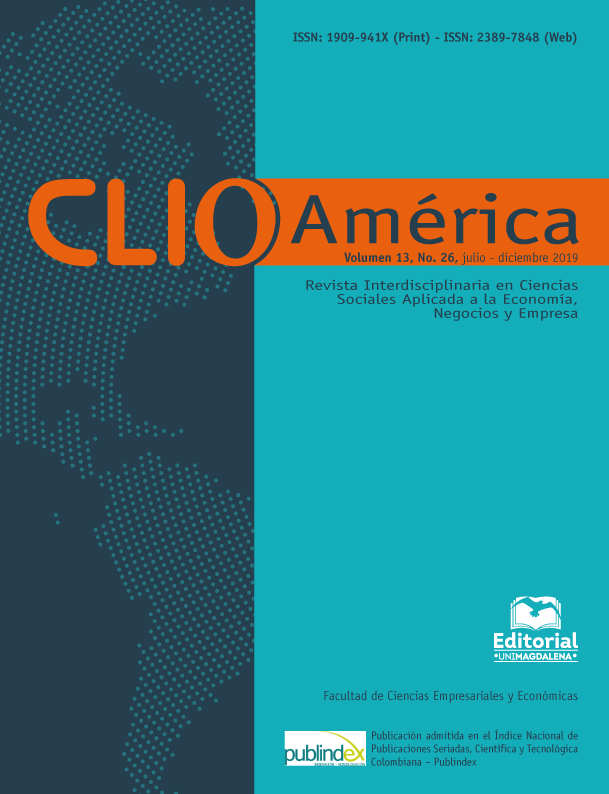Abstract
The main purpose of this article is to determine what is the impact of financial inclusion policies in the city of Monteria (Colombia). Hence; the importance of exposing the factors that have been influencing compliance with these policies in the municipality of Monteria. The methodology of this empirical research emphasizes a field work that favored the application of primary sources, with statistical support, through a correlational analysis (simple linear regression), in order to identify which are the variables of greater incidence for the financial inclusion of the population of popular strata in Monteria. The results provide empirical evidence that the lower-income population sectors in Monteria have less possibilities of financial access, because they do not have sufficient guarantees to meet the payment of said credits; in this sense, greater financial inclusion is required towards the homes of the popular sectors in said municipality. Based on these findings, it is concluded that a greater financial inclusion for the municipality of Monteria will favor the development of more entrepreneurial actions that activate the local economy and achieve higher levels of well-being in the Monteriana population.References
Allen, F.; Demirgüç-Kunt, A.; Klapper, L., y Martínez, P. M. (2016). The Foundations of Financial Inclusion: Understanding Ownership and Use of Formal Accounts. Journal of Financial Intermediation, 27, 1-30. Recuperado de https://revistas.javeriana.edu.co/files-articulos/CC/18-45%20(2017)/151555055004/.
Appleyard, L. (2011). Community Development Finance Institutions (CDFIs): Geographies of Financial Inclusion in the US and UK. Geoforum, 42(2), 250-258. Recuperado de https://revistas.javeriana.edu.co/files-articulos/CC/18-45%20(2017)/151555055004/.
Banca de las Oportunidades, BdO y Superintendencia Financiera de Colombia, SFC (2012). Reporte de inclusión financiera 2011. Bogotá: Banca de las Oportunidades, Bancoldex – Banco de Comercio Exterior de Colombia S.A., BdO y Superintendencia Financiera de Colombia, SFC. Recuperado de
https://www.superfinanciera.gov.co/descargas?com=institucional&name=pubFile1000970&downloadname=18052012reporteinclusion.pdf
Bayero, M. (2015). Effects of Cashless Economy Policy on Financial Inclusion in Nigeria: An Exploratory Study. Procedia - Social and Behavioral Sciences, 172, 49-56. Recuperado de https://revistas.javeriana.edu.co/files-articulos/CC/18-45%20 (2017)/151555055004/.
Bernad, C.; Fuenteslsaz, L., y Gómez, J. (2008). Deregulation and its long-run effects on the availability of banking services in low-income communities. Environment and Planning A., 40(7), 1681-1696. Recuperado de
https://intellectum.unisabana.edu.co/bitstream/handle/10818/22874/Mar%EDa%20Luisa%20Jaramillo%20G%F3mez%20%20(tesis).pdf?sequence=1
Comisión Multisectorial de Inclusión Financiera, CMIF (2015). Estrategia Nacional de Inclusión Financiera. Lima, Perú: Ministerio de Economía y Finanzas. Recuperado de
https://revistas.javeriana.edu.co/files-articulos/CC/18-45%20(2017)/151555055004/.
Committee on Financial Inclusion, CFI (2008). Report of the Committee on Financial Inclusion. New Delhi: Committee on Financial Inclusion, CFI. Recuperado de
https://revistas.javeriana.edu.co/files-articulos/CC/18-45%20 (2017)/151555055004/.
Chakravarty, S., & Pal, R. (2013). Financial inclusion in India: An axiomatic approach. Journal of Policy Modeling, 35(5), 813–837. Recuperado de http://www.igidr.ac.in/pdf/publication/WP-2010-003.pdf.
Cano, C.; Esguerra, M.; García, J.; Rueda, L., y Velasco, A. (2014). Inclusión financiera en Colombia. Banco de la República. Colombia. Recuperado de
http://repositorio.banrep.gov.co/bitstream/handle/20.500.12134/6618/6.%20Inclusi%C3%B3n%20financiera%20en%20Colombia.pdf?sequence=2&isAllowed=y.
Cecchetti, S.: Flores, L., & Krause, S. (2006). Financial Development, Consumption Smoothing, and the Reduced Volatility of Real Growth. Working Paper AEA. Recuperado de
https://www.banrep.gov.co/sites/default/files/eventos/archivos/sem_357.pdf.
Castaño, G. (2018). Futuro de la Inclusión Financiera Hacia la innovación sostenible y responsable en el sector financiero. Superintendente Financiero. Cartagena de Indias. Recuperado de
file: ///C:/Users/User/Downloads/20180718asomicrofinanzas%20(1).pdf.
Departamento Nacional de Planeación (2006). Consejo Nacional de Política Económica y Social, Conpes 3424 de 2006. Colombia. Recuperado de https://revistas.javeriana.edu.co/files-articulos/CC/18-45%20(2017)/151555055004/m.
Chibba, M. (2009). Financial Inclusion, Poverty Reduction, and the Millennium Development Goals. European Journal of Development Research, 21(2), 213–230. Recuperado dehttps://www.banrep.gov.co/sites/default/files/eventos/archivos/sem_357.pdf.
Demirguc-Kunt, A.; Klapper, L.; Singer, D., y Van Oudheusden, P. (2015). The Global Findex Database 2014: measuring financial inclusion around the world (English). Policy Research working paper; no. WPS 7255. Washington, D.C.: World Bank Group. Recuperado de https://www.asobancaria.com/wp-content/uploads/Ensayos-sobre-inclusion-04051727-04-2018.pdf
García, N.; Grifoni, A.; López, J., y Mejía, D. (2013). La educación financiera en América Latina y el Caribe. Situación actual y perspectivas. Caracas: Corporación Andina de Fomento, CAF, Banco de Desarrollo de América Latina. Recuperado de https://www.oecd.org/daf/fin/financial-education/OECD_CAF_Financial_Education_Latin_AmericaES.pdf
Global Financial Development, GFD (2013). Global Financial Development Report: Rethinking the Role of the State in Finance. Washington: International Bank for Reconstruction and Development, the World Bank. Recuperado de https://revistas.javeriana.edu.co/files-articulos/CC/18-45%20(2017)/151555055004/.
Kumar, A.; Narain, S., & Rubbani, S. (2015). World Bank Lending for Financial Inclusion: Lessons com Reviews of Select Projects. Washington: Independent Evaluation Group, e World Bank Group. Recuperado de https://revistas.javeriana.edu.co/files-articulos/CC/18-45%20 (2017)/151555055004/.
Leeladhar, V. (2006). Taking Banking Services to the Common Man – Financial Inclusion. Reserve Bank of India Bulletin, New Delhi. Recuperado de: https://revistas.javeriana.edu.co/files-articulos/CC/18-45%20 (2017)/151555055004/.
Organización para la Cooperación y el Desarrollo Económico, OECD (2016), Financing SMEs and Entrepreneurs 2016: An OECD Scoreboard. OECD Publishing, Paris. Recuperado de https://www.asobancaria.com/wp-content/uploads/Ensayos-sobre-inclusion-04051727-04-2018.pdf
Roa, M. (2013). Inclusión financiera en América Latina y el Caribe: acceso, uso y calidad. Boletín del Centro de Estudios Monetarios Latinoamericanos (CEMLA), 121-148. Recuperado de http://www.cemla.org/PDF/boletin/PUB_BOL_LIX03-01.pdf
Rodríguez-Lozano, G. (2017). Inclusión financiera en Colombia. Análisis de su evolución en términos de eficiencia relativa. Universidad Nacional de Colombia. Recuperado de
https://revistas.javeriana.edu.co/files-articulos/CC/18-45%20 (2017)/151555055004/.
Salas, Q. (2015). Financiamiento del Sector Industrial de las MIPYMES en el Municipio de Sincelejo. Universidad Nacional de Colombia. Recuperado de
http://bdigital.unal.edu.co/49976/1/Heberto%20Salas.2015.pdf
Solo, T. (2008). Financial Exclusion in Latin America – Or the Social Costs of Not Banking the Urban Poor. Environment and Urbanization, 20(1), 47-66. Recuperado de
https://revistas.javeriana.edu.co/files-articulos/CC/18-45% 20(2017)/151555055004/.
Thorat, U. (2006). Financial Inclusion and Millennium Goals. New Delhi: Reserve Bank of India. Recuperado de http://sustainabledfs.lbs.edu.ng/FI-Resources/2006_Thorat.pdf
Vera, C., y Titelman, D. (2013). El sistema financiero en América Latina y el Caribe: una caracterización. Santiago de Chile: Comisión Económica para América Latina y el Caribe, CEPAL, Serie Financiamiento para el desarrollo. Recuperado de
https://revistas.javeriana.edu.co/files-articulos/CC/18-45%20(2017)/151555055004/.

This work is licensed under a Creative Commons Attribution-NonCommercial-ShareAlike 4.0 International License.

